From Containing Us to Sustaining Us
A Literature Review Towards Culturally Sustaining Pedagogy and Computer Science
by Nery Antonio Chapetón-Lamas Jr.
Introduction
We keep spending most our lives Living in a gangsta’s paradise
- Coolio ft. LV, “Gangsta’s Paradise”
In the 1995 U.S. Billboard biggest-selling single, Coolio describes the reality and power of the paradise he lives in. There are hints where he alludes to the opposite, though, like his momma thinking he's lost it, tv showing him a different life, having no choice because of what he's born into, and reflecting on death. The latter follows with LVs refrain, “Tell me why, we’re so blind to see, that the ones we hurt are you and me”. Regardless of who the "you" may be referring to, the song's construction and LVs deep, melodic voice with angelic hymnal backgrounds feels like his conscious or inner voice speaking. The voice fluctuates between the hook and the refrain. But when you listen to LV’s version of the song, his solo version the year after Coolio's release, it expands and even flips the meaning of the song. In the refrain, LV says “Ain’t no gangstas living in paradise”. In an interview, Coolio mentions how "Gangstas paradise is about how you're being controlled." These parts clicked together and made me reflect on the paradise I had constructed given the options I was born into.
Growing up in northeast Los Angeles during the 90s, my parents and I worked hard to keep me away from a stereotypical gangsta's paradise. Growing up hood-adjacent meant these lived experiences were close enough. It wasn't hard to go unnoticed, skinny nerdy kid always wearing the same jeans or cargo shorts, same white t-shirt, going straight to school and back, being picked up by señoras my parents paid to drive me from the bus stop to our house. Hyperfocusing on academics, keeping friend circles small and tight, and our parents distancing us from family that could be "bad influences" created a need for expression or some way to stretch. Nerdom was that stretch, a way to connect with humanity and community with a shared love of scifi, fantasy, superhero comics, video games, and books. This is where my love for computing spawned from. From seeing the computer and internet as a gateway to so many of my interests, to a tool to obtain more for someone from our socioeconomic status, to a curiosity of a technological universe that encouraged exploration.
But beyond growing up, the evolution of that paradise needed to happen to keep up with the oppression of academia. Going into higher ed, STEM fields, and graduate school meant the paradise needed to change, almost entirely anew. Instead, it was adapted and cobbled together like the last one, with whatever was readily available. Like Coolio says, “They say I gotta learn, but nobody’s here to teach me. If they can’t understand it, how can they reach me?” It becomes a push back into continuing the construction of his paradise to survive the given circumstances. The parallel in academia of the promise of liberation through education, the promise of passionate and inspirational educators, the promise of growth and mentorship, that line hits especially hard on the other side. Moreso now that I’m familiar with work behind equity and anti-racist education. Too many people frontin'
I reflect on my years since adolescence, since graduating, since obtaining tenure, and am proud of who I've become as a person and educator. But my inner voice, my LV, sings the questions of what could have been. What if someone was there to teach me? The way I deserved as a Chicano in STEM/CS. What if someone did understand that experience of being from the hood, or hood adjacent, and could reach me? I was one of the "lucky ones" that had enough mentors and support to get me here, to help me survive the ivory towers. But what if that was used to thrive? What would that have looked like?
Exploring culturally sustaining pedagogies and practices in CS is more than an academic endeavor. More than a literature review, an article or book, a sabbatical project. It is deconstructing decades of paradises built to create a more beautiful, empowering, and caring reality that I was promised and deserved. I hope to spend most of my life constructing that gangsta reality. I hope even more to do it in community with colleagues and co-conspirators that don't need convincing or dragging. Struggles, conversations, humility, mistakes and learning notwithstanding. This literature review includes some of that support, through the foundational texts section, but ultimately it was made for scholars like myself. The ones that grapple, even within their paradises, to see themselves as experts, engineers, scholars, educators, and struggle even harder to own it. This is for the beginning of a new journey of teaching to transgress in CS, unapologetically with courage and conviction, through the valley of the shadow of the academy.
Teaching and Learning
These materials provide specific pedagogical approaches relevant or foundational to CSP, they frame this whole literature review. A good space to start and the space we must continuously come back to, refreshing a teaching and learning mindset that centers our students humanity
Culturally Sustaining Pedagogies: Teaching and Learning for Justice in a Changing World

by Django Paris
"As though our lives have no meaning and no depth without the White gaze. And I have spent my entire writing life trying to make sure that the White gaze was not the dominant one in any of my books."
-Toni Morrison
Foundational text to the whole literature review, the density of the book comes in its deep philosophy, details of research studies, and rich examples that demonstrate the potential of CSP approaches in the classroom. CSP is comprised of three principles that will guide the reflections in the literature review:
1) "Demanding explicitly pluralist outcomes that are not centered on White middle-class, monolingual/monocultural norms and notions of educational achievement-- and that call out the imposition of these norms as harmful to and discriminatory against many of our communities"
2) "Resist static, unidirectional notions of culture and race that center only on longstanding cultural practices of communities without also attending to continual shifts and cultural reworkings"
3) "Willing to seriously contend with the sometimes problematic aspects of our communities, even as we celebrate our progressive, social justice-oriented movements and approaches" (p. 12)
Take Object Oriented Programming (OOP), using agile software development strategy, as an example to better understand CSP. If a requirement is incorrect when designing the model, or the infrastructure is faulty, you end up building an application on a bad foundation. Agile development may make it easier to recover than a waterfall approach, but either way we eventually identify the root cause of the issues in our software through testing and debugging. This systemic approach to systematically change things is core to equity and social justice. You reckon with the massive amount of work you're "losing", but you must do a massive overhaul because the logic proves the failing is so critical it requires a redesigning and replanning from the start. How expansive the changes are depends on the situation, of course, but we teach our students that if it's in those final stages of the software development lifecycle it can have devastating consequences. We can look at our teaching in the same way: What if the way we've been teaching, primarily lecture-based with open lab-style activities, is not working? We may think it works from some anecdotal accounts, but our departmental (and nation-wide) data show otherwise: equity gaps with women and BIPOC graduating with CS degrees, hired for technical roles or leadership positions, obtaining seed funding for start-ups, and more. Looking at whether we teach a functions-first approach vs. an objects-first approach vs. programming language choice vs. IDE choice is the surface. It's important and warrants conversation, of course, but much like solving front-end bugs that are caused by back-end/architecture issues, it's not deep enough. We need to look at our teaching practices, specifically equity-minded practices like CSP that are "not interested in offering pedagogical quick fixes or "best practices" that teachers can drop into the same old tired curriculum that deadens the souls of vast numbers of [students] of color in U.S. schools'' (p. 12). What we're looking at here is a whole new way of intentionally thinking of teaching by centering those three principles.
Culturally Responsive Teaching and The Brain: Promoting Authentic Engagement and Rigor Among Culturally and Linguistically Diverse Students

by Zaretta L. Hammond
"Love is an act of courage, not fear...a commitment to others...[and] to the cause of liberation"
- Paulo Freire
Through brain-based learning strategies from neuroscience, Hammond encourages us to to connect the heart and brain in learning through six core design principles:
1) The brain seeks to maximize opportunities to connect with others in community (collectivist) and minimize social threats
2) Our safety-threat detection system (fight, flight, freeze) is kept in check by positive relationships
3) Culture guides how we process information
4) Engagement drives learning
5) Couple new information with existing funds of knowledge (learning is like climbing a wall, not painting on a new canvas)
6) Encourage neuroplasticity by promoting growth through challenge, stretching one's ability to do more complex thinking and learning.
At times, CSP and CRP feel like one in the same. There’s a lot of truth to that as Paris’s book references Hammond’s approach heavily while expanding on it by contending with problematic aspects in our community. They share the foundation that Hammond builds on empowering minoritized students by challenging our own teaching practices. By focusing on relevant and focused problem solving through the principles above, we can build those cognitive skills while validating and affirming our students' full humanity. The latter parts are severely lacking in most traditional CS classrooms, keeping in mind Hammond’s design principles above will provide a framework as we interrogate our own practices while building new ones in CS. If you're struggling with the CSP reading, this one can be a great springboard to get back to CSP by going deeper into fundamentals like collectivist vs. individualistic approaches, meritocracy, etc.
Teaching To Transgress: Education as the Practice of Freedom
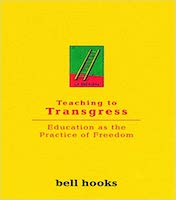
by bell hooks
"[A]ny radical pedagogy must insist that everyone’s presence is acknowledged. That insistence cannot be simply stated. It has to be demonstrated through pedagogical practices. To begin, the professor must genuinely value everyone’s presence."
- bell hooks
hooks recounts the powerful experiences of going from segregated to desegregated schooling that many of us blanketed as a positive and win for social justice. Her lived experience of going from a black school (joy and ecstasy, pleasure and danger in challenging norms from home, space to reinvent oneself) to no longer countering hegemony (responding and reacting to white folks always and only). Regardless of the change, school had been a political place and her journey through higher education was no different: a continuation of learning obedience to authority, learning “a lot about the kind of teacher I did not want to become” (p. 5). Freire and feminist pedagogies tackled these ideas, but not the pleasure and excitement of learning in higher education. In talking about boring vs. fun classrooms, hooks explores a notion of teaching as a “performative act” as a vehicle for bringing out the uniqueness of each classroom.
I remember often saying to my classes, on the first day of class, that the more they opened up and got to know me the better I could cater the class to them. Whether it was through programming examples or lectures, I vowed to modify and adjust depending on the specific set of students that semester. I would proceed to handout the prescribed schedule of topics of the semester, which rarely got adjusted, and started the first programming topic that would serve as a template for the rest of the semester's projects. Through hooks’ book I realized the restrictiveness of my structured approach to a space for students to draw out the uniqueness of my students. I had always seen lecturing as a performance, but hooks clarified the performance, not in the traditional definition of the word but as an invitation for students (and faculty) to become more engaged and actively participate in learning. It became the invitation I needed to hear to get excited about education again, to explore teaching and learning that is liberatory. Every artifact I introduce or build for the classroom supported this or disrupted it, pursuing this would require deep and constant reflection on what I thought were "good practices" that were tried-and-true. But tried-and-true for who?
Sentipensante (Sensing/Thinking) Pedagogy: Educating for Wholeness, Social Justice and Liberation
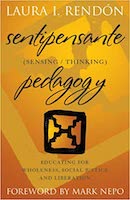
by Laura I. Rendón
“I feel, therefore I can be free ”
- Audre Lorde
The Mayan tradition of In Lak’ech, “you are my other me” or “I am you and you are me”, of unity is present in other cultures: the Chinese notion of yin and yang, in am and duong belief from Vietnam, Hindu gesture of namaste, and the African philosophy of ubuntu. All connect two seemingly separate halves and recognize their interconnectedness and indivisibility. In U.S. education, we have learned to quiet our emotions and see learning as bits and bytes disconnected from the real-world. We call it simplifying the problem, abstraction, etc. and as much as it has its place in learning, it is destructive to learning when it is divorced from the whole. Rendón covers a history of education to modern approaches, like engaged and critical pedagogy. The powerful challenge of “a truly educated person is not simply one who has acquired great knowledge or who holds advanced degrees. Una persona educada [An education person] is one graced with wisdom and able to apply knowledge and insight, intuitive awareness, and common sense” (p. 88). This approach, especially with oppressed students, of an ethic of care, validation, and compassion, can liberate students and faculty alike from themselves.
At first, Rendón’s approach of Sentipensante (sensing and thinking) felt like it short circuited my brain. What does that even look like in CS, when I’ve never seen or experienced it in a STEM classroom? I had experiences one-on-one with students, sharing their humanity with me in stories of academic oppression, STEM trauma, personal and life challenges, but how could that be scaled to a whole classroom every week for a semester? Luckily, we have examples in our field of subfields, companies, and endeavors that have attempted it. The Ubuntu operating system, for example, takes its name from the African philosophy of “the belief in a universal bond of sharing that connects all humanity.” The free and open-sourced Linux distribution was built with that in mind, but Rendón’s idea of liberation for faculty felt foreign, if not impossible. “When faculty employ a multi human cannon, they liberate themselves from the myth of monoculturalism and the notion that humanistic, contemplative approaches cannot coexist with intellectual ways of knowing" (p. 140). That moment of realization paralleled in CS when I learned I could solve a set of problems with one algorithm that was abstract and flexible enough to be useful for all. Rather than try to create a curriculum for each individual potential student in the class, why not invite the students to create that curriculum with us?
Grading for Equity
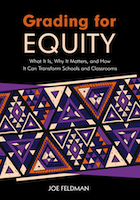
by Joe Feldman
"[G]rading seemed to tap directly into the deepest sense of who teachers were in their classroom."
- Joe Feldman
With many of the readings in this literature review, it requires a stretch of our skills and, moreso, imagination to apply it to a CS context. This is especially true in this section that focuses on teaching and learning, inching us closer but still requiring a big stretch. Feldman’s book may strike the strongest cord with faculty, both in how deep it connects with our teaching spirit and how practical many of the approaches are. Touching on the personal parts of what makes grading so difficult to discuss and change, brief history of grading to give context, breaking down how traditional grading stifles risk-taking and supports the "commodity of grades", hides information, invites biases, provides misleading information, demotivates and disempowers. Feldman proposes a new vision of grading with the three pillars: accuracy, bias-resistant, and motivation. Each chapter breaks down multiple strategies, research studies, and examples on how to implement the changes.
Basic changes you can make are described early on with the case against the Zero and 0-100 scale by adopting minimum grading (the easiest change you can make right now), or switching to 0-4 scale. It breaks down mathematical inaccuracies of traditional grading practices (i.e. averages) that are eye-opening, examining (and removing) extra credit, alternative (non-grade) consequences for cheating, alternatives to late work grade penalties, and excluding participation/effort. It also goes into motivation of grades (redoes, retakes, mistakes in learning), and using rubrics, all essentially refocusing on learning. The challenging of supposed objectivity and the potential negative impact we’ve been having on our students for our many years of teaching is sobering at best, devastating in reality. Grading practices are a great example of systemic processes that create barriers to learning, reckoning with the feelings and thoughts brought up opens up a new world of student and faculty empowerment that will only improve education.
Reinventing Paulo Friere A Pedagogy of Love
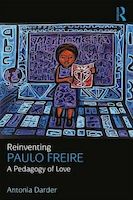
by Antonia Darder
"What has been ignored is the manner in which class formations and implicit beliefs, attitudes, and values tied to a global coloniality of power are interpellated through dominant cultulral and class expectations--expectations defined by the interests of the economically and politically powerful and carried out by the country's most inconspicuous moral leaders--namely, teachers."
- Antonia Darder
The book starts with going over neoliberaly globalization and capitalism, how it connects to education through economic inequality, coloniality, and exclusion by way of neoliberal education reform. It provides a good overview for international faculty by giving a lot of good context to US school systems. For non-immigrant faculty, especially those that went through the systems described, it is validating to know why our schooling was so bad. It also provides context to talk about CS education after K-12 and how our teaching perpetuates all of these learned academic behaviors. Darder also challenges "the unbridled advancement of STEM education [that] must be understood then in concert with expanding U.S militarization, rather than simplistic interpretations of science as "the new frontier"" (p. 20). It is an important reality for the context of STEM education, not one or the other but both must be acknowledged. Along with how STEM education is used, she questions the myths of a classless society, myth of social mobility, and myth of school choice in US education. Darder extends and expands the work of Freire and other critical scholars, “that schools are significant sites of struggle and that teachers, who embrace an ethical responsibility as citizens and subjects of history, are in an ideal position to collectively fight for the reinvention of the world...Hence, an important role of educators is not only to unveil the official transcript of schools and society but also to work toward the decolonization of everyday life, in ways that support the reinstitution of a multiplicity of historical memories and epistemologies tied to the survival of historically oppressed communities" (p. 36).
Ideas like multiplicity of experiences from oppressed communities is explored in some of the other pieces of this literature review. For me, the intro was the most impactful part, providing such rich context for the rest of the chapters that focus on praxis (the idea of practice, reflection, and practice) and the revolutionary power of teaching as an act of love that Freire affirmed. Going back to how we envisioned ourselves as teachers at a much earlier age, it brings to light the pedagogy of questioning against pedagogy of answers. The last chapter does a great job of connecting it all through examples of teaching praxis, how they connected students' narratives and lived realities to their subjects. Again, a pedagogical and cognitive stretch is required to see how to incorporate these lessons into CS classrooms but the mindset and spirit of this text will guide us as we explore what CSP looks like in CS.
Self Care
These materials provide personal tools for self/community care, as we embark on this work to build a just and equitable classroom we will reflect and engage with past experiences, trauma, and personal beliefs that will be difficult. Taking care of oneself is critical, especially for BIPOC and most especially BIPOC women, for longevity and deep cultural shifts. In the words of Audre Lorde, "Caring for myself is not self-indulgence, it is self-preservation, and that is an act of political warfare."
Love and Rage: The Path of Liberation Through Anger
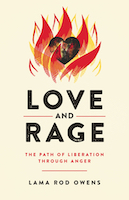
by Lama Rod Owens
"But anger expressed and translated into action in the service of our vision and our future is a liberating and strengthening act of clarification, for it is in the painful process of this translation that we identify who are our allies with whom we have grave differences, and who are our genuine enemies. Anger is loaded with information and energy."
- Audre Lorde
Lama Rod Owens defines “anger” as the experience, both mental and physical, of emotional pain and finding a way to tend to that pain. The expression of anger is derived from that tension, resulting in violence or self-protection rather than self-care. As I read this book through a global pandemic, the isolation associated with it and a sabbatical, it challenged me to recognize, name, experience, and process my anger. Anger that I’ve felt for much of my life and learned to bottle, to weaponize as I obtained more accolades and power. By slowly progressing through the book, I absorbed the lessons that my anger could transform into wisdom and the liberation that brings with it. I would recommend not rushing through this reading, breaking it into digestible chunks gave me space to think and feel while also practicing what I learned. In that way, I felt more capable, less frustrated, and practiced a liberatory approach where I try not “saying “I am angry” [which] is such a suffocating phrase with no potential for growth, movement or freedom…” (p. 107). Instead, I acknowledge that “I am experiencing anger” and allow the anger to drop some knowledge on me.
"Since the 2016 presidential election, shit has been hard for some of us. For the rest of us, shit has been hard for a while" (p. 11). I vividly remember taking a shower the morning after the election, how powerless and devastating it felt but knowing my socioeconomic status, skin complexion, and so many other privileges would protect me from what was coming. I feared for my community, my friends, my family, and so many that Owens summed up at “the rest of us”. I also remember walking into the classroom and not knowing what to say to my students, so I did what I’ve learned and done my whole life: park it at the entrance, put your head down, and work. So I did, and years later when my students transferred, graduated, and met up for lunch they recalled that memory. How I looked, moved, talked that day, they felt like I felt but the few of us people of color in that space did what we were used to: park it, head down, work. I’ve grown as an educator and person since then, doing my best to do better. Owens provided language and validation for so much anger stored up over a lifetime to be the person and educator he describes: "I believe that one of the primary roles of a teacher or guide is to reflect our basic wisdom and joy back to us so we can see for ourselves that these beautiful qualities are a part of us. Seeing them for ourselves helps us to believe in them, maybe for the first time in our lives" (p. 71). By healing and learning to do better, I can show up for my loved ones fully. That includes my students I will strive to be a mirror for.
Rest: Why You Get More Done When You Work Less

by Alex Soojung-Kim Pang
“If your work is your self, when you cease to work, you cease to exist.”
- Alex Soojung-Kim Pang
Pang goes over some of history's most accomplished thinkers and creatives, as well as work in neuroscience and psychology, and how they organized their lives around their work while incorporating what he calls "deliberate rest". There are powerful notions of using rest as a skill, harnessing mind-wandering while resting (letting your unconscious mind explore new ideas), making time for rest often (daily schedule), and rest as a resource to extend your creative life. Rest as a fountain for creativity is important to recognize, as Pang reminds us that "if you want rest, you have to take it. You have to resist the lure of busyness, make time for rest, take it seriously, and protect it from a world that is intent on stealing it."
As we embark on this journey of decolonizing CS by applying CSP in CS, we're embracing ideas that challenge our ways of thinking, beliefs, and past practices. Recovering and resting from that deep reflection to better apply it to our teaching (praxis) is important. It allows our creative minds to recover and refuel for the work ahead. Taking advantage of the mind-wandering that will allow the synapses in our brain to connect the theory of what we've learned encourages our creative mind to explore these ideas in the tangible activities of the classroom. By resting, we give space to bring those theories to life with our students, creating the liberatory education they deserve. At the very least, when we take care of ourselves we can show up more like ourselves for our students and be more patient, more supportive, and kinder.
Social Context
These materials provide social, political, historical context to the literature review. Most of the books start of with some kind of historical/social context, but if you are struggling with some of the broader racialized ideas, white supremacy, and historical/modern impacts, this is a good space to visit
How to Be an Antiracist

by Ibram X. Kendi
“In a racist society it is not enough to be non-racist, we must be anti-racist.”
- Angela Davis
A very approachable book that can challenge your ideas of racism, both its definition and how it shows up in all facets of our lives. Kendi explores it in each chapter through sexuality, gender, color, class, and more. He weaves historical contexts, culture, and his own personal journey to explore the variety of ways racism and, in turn, anti-racism manifests. It is a great start on the journey of anti-racist texts that can be further explored through authors that laid the groundwork before Kendi, like Angela Davis, bell hooks, Audre Lorde, W.E.B. DuBois, Malcolm X, Dr. Martin Luther King Jr., and more.
This literature review goes over books that talk about race and gender in CS education, even some (like "Kicking Butt in Computer Science: Women in Computing at Carnegie Mellon University") that have demonstrated positive impacts for women in CS in higher education. Finding examples of bridging those CS equity gaps around race is harder to find. Becoming more familiar with how racism manifests, especially for those of us that haven't experienced what it is to be Black in this country, is important to begin to engage in those dialogs and critiques within our field to make those deeper systemic changes we've seen have proven successful at institutions like Carnegie Mellon University. As we acknowledge, interrogate, and engage with racism/anti-racism in our society/lives, we can build a foundation to look within our field/classrooms to ask the question: What does antiracist CS education look like?
Stamped: Racism, Antiracism, and You
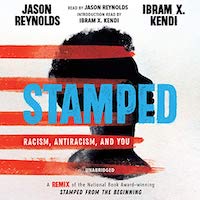
by Jason Reynolds, Ibram X. Kendi
“Segregationists are haters. Like real haters. People who hate you for not being like them. Assimilationists are people who like you, but only with quotation marks. Like…’like’ you. Meaning, they ‘like’ you because you’re like them. And then there are antiracists. They love you because you’re like you.” (P. 3)
Kendi breaks down the construct of race fro a historical and social perspective, going back to its origins and connecting it to the form racism takes place today. How these ideas have been easy to create and perpetuate, but also how they can be dismantled. Provides a lot of context and background information that compliments "How to Be an Antiracist" very well if you're not familiar with the legacy of racism in America.
Much like understanding frameworks or paradigms is important in software development, understanding the framework of racism built into this country is important to interrogate racist ideas that exist in our society, in our field of CS, and how they all intersect. By reflecting on this broader historical and social context, one can connect the dots to how endemic these ideas are that run rampant in tech as well. We can then see how they specifically take shape within tech, and begin to diagnose and strategize how to dismantle those practices/policies to create institutions, spaces, and hardware/software that is anti-racist.
Why We Can’t Wait
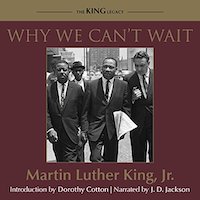
by Dr. Martin Luther King Jr.
“For years now I have heard the word "Wait!" It rings in the ear of every Negro with piercing familiarity. This "Wait" has almost always meant "Never." We must come to see, with one of our distinguished jurists, that "justice too long delayed is justice denied.”
- Dr. Martin Luther King Jr., Letter from Birmingham Jail
Dr. Kings account of the Birmingham campaign during spring and summer of 1963, which includes the infamous "Letter from Birmingham Jail", provides a powerful background to the texts in this category and the CS-specific ones that deal with race. It is a sobering reminder, both of our countries history of racism and its present form with recent human rights movements like #BlackLivesMatter. The parallels that ring true almost 60 years later provide a contextual backdrop that implore us to reckon with the so-called "post-racial America" we live in and can empower us to wait no longer for the change we want to truly see.
For an industry that prides itself on the speed of innovation and discovery, reminders of how slow large institutions and systems are to change can be frustrating. "Why We Can't Wait" points to the lived experiences of Black people in our country, encouraging us to draw on the parallels we see today and hopefully how they manifest in CS. By reflecting on how the past and present connect, we can apply our spirit of innovation and discovery to this context and leverage it in our teaching and learning within CS to at least disrupt those practices that perpetuate the waiting Dr. King describes. The frustration of waiting for innovation is a privilege for non-Black folks, this text serves as a reminder that solidarity in these movements is essential. What that looks like in CS education and industry is up to us to figure out and discover.
Freedom Is a Constant Struggle: Ferguson, Palestine, and the Foundations of a Movement
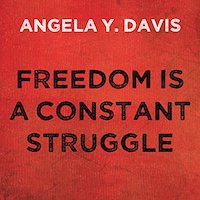
by Angela Y. Davis
“I feel that if we don't take seriously the ways in which racism is embedded in structures of institutions, if we assume that there must be an identifiable racist who is the perpetrator, then we won't ever succeed in eradicating racism.”
- Angela Davis
In a collection of speeches, essays, and interviews, Angela Davis connects so many struggles together to remind the reader of how solidarity in our shared struggles against racism, homophobia, xenophobia, misogyny, etc. is essential to our collective freedom. Whether it's through examples of Palestine, Ferguson, the prison industrial complex, the Black freedom movement, Southern African antiapartheid, etc., Davis reminds us that "every change that has happened has come as a result of mass movements".
This text prompts us to think of how CS, both in the classroom and in our industry, are connected in this shared struggle. By interrogating the ways in which CS perpetuates those struggles, such as innovations being used by the military industrial complex (i.e. drones), we can begin to identify those intersections and our role within them. At the very least, we can empower our students (and even ourselves) to make more informed decisions going forward that align with our values. At a more metacognitive level, this systemic and systematic approach of looking at each struggle as connected triggers for me the way we approach architectural problems and design solutions that get at the core issues or flaws of our systems. This is another reminder of how our CS mindset and social justice mindset intersect, that they are not so different but one in the same. How can we use that to empower learning, and by extension empower students and faculty to affect change in our world?
CS Culture
These materials provide CS-specific context in industry and academia. If you're not as familiar with the details of the disparities and inequities for minoritized communities in CS (women, BIPOC) this is an important space to spend some time in
Kicking Butt in Computer Science: Women in Computing at Carnegie Mellon University
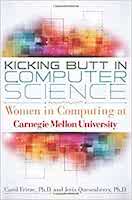
by Carol Frieze
"If we're going to out-innovate and out-educate the rest of the world, we've got to open doors for everyone. We need all hands on deck, and that means clearing hurdles for women and girls as they navigate careers in science, technology, engineering, and math."
- First Lady Michelle Obama
Carnegie Mellon University has been known for its progress in reaching gender parity, they closed the gender gaps by using “straightforward practices that have proven to be successful...it’s not rocket science!” (p. 2). Their strategies operated at the institutional, departmental, and individual levels with their respective supports. They’ve done everything from change their admissions process and changing curriculum/pedagogy to starting and supporting their Women@SCS (School of Computer Science) program. In their research, they tracked the evolution of their program from the gender divide of seeing men as “dreaming in code” while women “compute with a purpose”, changing their admission policies, and making curriculum “female friendly”. The biggest changes came from shifting departmental culture, seeing women as capable in CS, as well as integrating their Women@SCS programs and their active group of graduate women that “was not left to develop as a marginalized women’s group, rather it was embraced as a professional organization to be integrated into the school as a valuable asset” (p. 30) that guided the cultural shift.
Although their research argues that making the learning more relevant wasn’t what made an impact, they actually shifted to a more theoretical/algorithmic approach later, I would argue that their existing racial equity gap could be partially influenced by this. I offer this not as reinforcing the stereotype that women, and BIPOC, are solely “computing with a purpose” but rather that choosing solely the algorithmic approach does the same: caters to a specific group of students that have a shared interest, in this case one that is commonly accepted in CS. Seeing how computing is relevant to their lives makes learning more manageable for everyone, and balancing between the two opens up computing to students with more diverse interests. From a CSP lens, combining these efforts could look like “dreaming and computing with a purpose” since both are valuable and needed, especially when looking at the societal impacts of CS. CMUs focus, however, is almost entirely on structural issues (faculty hiring/retention, department culture, institutional leadership, integrating student-led programs) that hits further into a social justice approach that would have lasting impact beyond curriculum changes. Both are valuable and needed, one often feeds into the other. As faculty (especially part-time faculty) we may feel like we only have control over one, but we need to be involved in both.
Brotopia: Breaking Up The Boys' Club of Silicon Valley
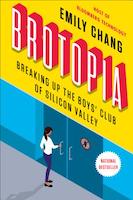
by Emily Chang
"[S]top blaming everybody else for the problem or pretending that it is too hard for us to solve. It’s time to look in the mirror. This is an industry, after all, that prides itself on disruption and revolutionary new ways of thinking. Let’s put that spirit of innovation and embrace of radical change to good use. Seeing a more inclusive workforce in Silicon Valley will encourage more girls and women studying computer science now.”
- Emily Chang
The #MeToo movement in tech may not have gotten the same exposure and attention as the one in Hollywood, but the impact was similar. Men exiting their own funds as venture capitalists, executives leaving their positions at companies like Amazon, Google, Intel, and more all being set in motion by "a young engineer at Uber, Susan Fowler, who accused her manager of propositioning her for sex. Her memo, remarkably, led to a company wide investigation of Uber's bro culture that revealed forty-seven cases of sexual harassment…" (p. 10). Women not only face overt sexism and sexual harassment in tech, they also experience the more commonplace microaggressions on a more frequence basis. Lack of professionalism, such as male venture capitalists that use to brainstorm and pitch ideas, Katrina Lake, CEO of Stitch Fix. She shared, "How many women want to get in a bikini and drink beers while pitching a business?" (P. 11). Economic reasons are often cited for the importance of women in tech ("70 to 80 percent of consumer purchases" (p.255)), but the retention of women in tech is important because of the role tech has in shaping our society. Millions of dollars have been spent on diversity and inclusion efforts with little change.
Everyone has a role to play in addressing the author's initial question that drives the book's purpose: "What went wrong? How did women get pushed to the sidelines? And what can be done?” (P. 8). Applying the CSP principles, we can reshape the three within the context of this book and our classroom:
1) Questioning and stopping to use tired practices and examples that harm women (i.e. assigning or letting students assign women non-technical roles during group projects, comments faculty make like "women make the best documentation", etc.)
2) Embrace the dynamicness of womanhood, femininity, etc. and bringing it into the classroom. Don’t treat them like a monolith
3) Sincerely address the problematic aspects of our CS community, including but beyond the sexual harassment endemic both in academia and industry. That extends to inclusion in intro classes, retention through course sequences, inclusion in technical and leadership roles, etc.
Unlocking the Clubhouse: Women in Computing
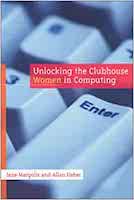
by Jane Margolis
"The goal is not to fit women into computer science as it is currently taught and conceived. Rather, a cultural and curricular revolution is required to change computer science so that the valuable contributions and perspectives of women are respected within the discipline."
- Jane Margolis
This book is the predecessor to “Stuck in the Shallow End”, which has a similar breakdown and approach but focuses on race rather than gender. Here, Margolis covers the full spectrum of reasons why the gender gap exists in CS industry and academia. Everything from gender socialization at a young age, how it continues in secondary school to further push girls away from computing, concerns and interests in computing not being offered in most CS curriculum, alienation of women in “geek culture”, confidence in a male-dominated field shifts over time and its connection to drops in interest. It empowers teachers to become active agents of change, what we can do to engage and protect girls interests in CS in K-12 education.
By now you may have noticed that many of the books on pedagogy focus on K-12, as the term andragogy is more appropriately what we should be looking at in higher education. Much of the research related to CSP, critical pedagogy, etc. has roots in K-12 and I’ve found few that focused on andragogy or adult learning. Although this might require another stretch, the research and findings are still powerful while also informing us as to the education our present students most likely received. Before reading these kinds of books and attending these kinds of workshops, I thought of my students as the empty vessel that walked into my classroom that I would fill with knowledge. The “banking model” view shifted to one where my students come in with a wealth of experiences and knowledge that can be used as leverage for learning CS. Books like this are a reminder that there’s also trauma and damage that comes along, if we are striving to be those loving educators Darder and Friere talk about, then we should create spaces for healing as well. Margolis’s coverage of girls in CS, although not as deeply intersectional with race as other readings in this literature review, provides a backdrop to what our students' experiences most likely align with in our classroom. This can inform our practices, challenging us to discuss and create content that aligns with those experiences to heal while learning.
Stuck in the Shallow End: Education, Race, and Computing
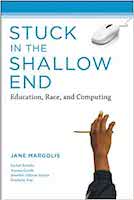
by Jane Margolis
"What John Dewey (1916) said almost a century ago is still true today: education will only prepare people for life in a democracy when the educational experience is also democratic. Unfortunately, Stuck in the Shallow End reveals how undemocratic our educational system still is in this technology age."
"What occurs in computer science education does not exist in isolation. As in other fields and activities where disparities in opportunties exist and are then rationalized, there are long-term consequences for both individuals and society. The history of segregation in swimming provides a powerful framework for these processes."
- Jane Margolis
Margolis’s second book follows her work from “Unlocking the Clubhouse”, focusing on high schools in Los Angeles Unified School District (LAUSD) and students who identify as African American, Latinx, and females in the traditional CS course sequence. The book sets up a powerful parallel with CS education, using the history of racism in the US, structural inequities and discrimination from segregation, socialization of steretoypes like Black people not knowing how to swim, and realities of the Black experience in the US that results in lives being risked as a whole community is “stuck in the shallow end”. "We identify "virtual segregation" as an insidious phenomenon that occurs when we are led to believe that we are moving toward equality, and pretend that everyone has a chance and a choice” (p. 2). Manifesting in vocational vs. professional work (worksheet classes vs. upper echelon AP CS courses), availability of quality opportunities, and the myth of the technological magic bullet manifest in students as showing little interest, understanding, and preparation.
It’s important to note that Margolis’s research showed that students coming from these under-resourced and ill-equipped schools (predominantly low-income and with students of color) may have taken programming courses, but they're heavy copy/paste and drill-and-kill courses that have been stripped of the higher-order thinking and problem solving required to get through CS. It also challenges us to think about how our educational system is let off the hook, placing the burden on underrepresented students by assuming that they are not interested or do not have the ability for CS, implying it is innate and fixed. Margolis artfully deconstructs these notions to replace the responsibility on our institutions shoulders, thereby reminding us of our duty as faculty members to balance reform in and out of the classroom.
Social Impacts of Computing
These materials provide direct connections between CS and social justice/oppression. If you are navigating the other spaces and are having trouble connecting them directly with CS, this is a great stop on your journey. Keep coming back for more examples that can be brought into the classroom, either as additional resources for current events to share with the class or context for in-class activities/projects. This space will have plenty of examples of the three CSP principles, especially the third one. Note that, as time passes, some specific examples will not hold true because of the speed of change in tech (i.e. specific search engine results). The deeper takeaways, about the impact tech had in that moment, are more important and will help you and your students understand more abstract ideas to apply to the current technological trends and identify modern examples of the social impacts of computing
Algorithms of Oppression
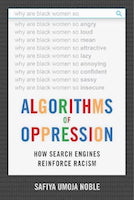
by Safiya Umoja Noble
"I am writing in the spirit of other critical women of color, such as Latoya Peterson, cofounder of the blog Racialicious, who has opined that racism is the fundamental [API] of the Internet"
- Safiya Umoja Noble
In a masterful piece of literature, Noble breaks down the power of algorithms and the ways they reinforce oppression socially and individually to shed light on how “technological redlining” is on the rise. She shows evidence and argues that big tech monopolies need to be broken up and regulated, demonstrating how it's a threat to democracy and individual freedom. As artificial intelligence and machine learning grows and become more prolific, the truly black-boxed tools will make it even harder to interrogate and revise, especially when privately managed and operated. She not only pushes for broader public discussions on these matters, but also provides a roadmap on how to have those conversations with a critical and intersectional lens that doesn’t require an intimate technical understanding. As CS faculty/technologists, we can sometimes write off these arguments because they do not take the “technical” into consideration, yet we preach the power of abstraction. Although our future is trending and the ideal would be for the public to have a fundamental understanding of computing/computer programming literacy, the reality is that computers have been prolific for almost half a century and we are still struggling with that literacy. “Alternatively, I draw an analogy that one need not know the mechanism of radio transmission or television spectrum or how to build a cathode ray tube in order to critique racist or sexist depictions in song lyrics played...even if we had algorithmic literacy, we still could not intervene in these private, corporate platforms" (p. 25). This is a great reminder for faculty that students can interrogate these systems, interfaces, and applications despite our intro CS courses not reaching the depth of their technical nature.
Another powerful realization from the book was how Noble points out that digital media platforms are characterized as “neutral technologies”, both by the public and academia. Because of this, “glitches” or “bugs” in the system are seen as one-off moments from a usually perfect system. Through the reading, we come to understand that, like software, “oppression operates in the same formats, runs the same scripts over and over. It is tweaked to be context specific, but it's all the same source code. And the key to its undoing is recognizing how many of us are ensnared in these same basic patterns and modifying our own actions” (p. 5). This heavy parallel between automation of code and oppression goes beyond the theoretical and metacognitive, Noble lays out many examples of how impactful it is to the individuals and our society when those two halves combine into algorithmic oppression.
The Intersectional Internet: Race, Sex, Class, and Culture Online
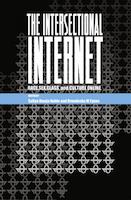
by Safiya Umoja Noble and Brendesha M. Tynes
"What has come forth in this volume is a way of thinking critically about the Internet as a system that reflects, and a site that structures, power and values."
- Safiya Umoje Noble and Brendesha M. Tynes
Intersectionality was a term coined by Kimberlé Williams Crenshaw in 1989 as a framework to analyze and understand how a persons social and political identities, namely gender and race for Black women, create multiplicative levels of oppression and discrimination. It honestly makes the most sense straight from the author's words: “[c]onsider an analogy to traffic in an intersection, coming and going in all four directions. Discrimination, like traffic through an intersection, may flow in one direction, and it may flow in another. If an accident happens in an intersection, it can be caused by cars traveling from any number of directions and, sometimes, from all of them. Similarly, if a Black woman is harmed because she is in an intersection, her injury could result from sex discrimination or race discrimination...But it is not always easy to reconstruct an accident: Sometimes the skid marks and the injuries simply indicate that they occurred simulataneously, frustrating efforts to determine which driver caused the harm” (p. 2-3). The book uses the lens of intersectionality to interrogate the Internet through a collection of papers from various authors, pushing the new and growing field of Intersectional Critical Race Technology Studies (ICRTS).
The papers from critical media and information studies scholars provide great examples of the intersection of CS with topics not usually discussed in traditional curriculum, topics often relegated to the social sciences. Instead, we can find a way (and a challenge) to engage in these conversations that we’ve opted out of, albeit because of a certain amount of fear. With our technical expertise, we can collaborate with Ethnic Studies, Sociology, and the Humanities to provide a realistic approach to CS that is grounded in our humanity. Our students have been craving this, and the other resources in this literature review point to the systemic need for it.
Weapons of Math Destruction: How Big Data Increases Inequality and Threatens Democracy
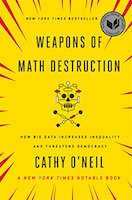
by Cathy O’Neil
"The privileged, we’ll see time and again, are processed more by people, the masses by machines."
"Racism, at the individual level, can be seen as a predictive model whirring away in billions of human minds around the world. It is built from faulty, incomplete, or generalized data. Whether it comes from experience or hearsay, the data indicates that certain types of people have behaved badly. That generates a binary prediction that all people of that race will behave that same way. Needless to say, racists don’t spend a lot of time hunting down reliable data to train their twisted models. And once their model morphs into a belief, it becomes hardwired. It generates poisonous assumptions, yet rarely tests them, settling instead for data that seems to confirm and fortify them. Consequently, racism is the most slovenly of predictive models. It is powered by haphazard data gathering and spurious correlations, reinforced by institutional inequities, and polluted by confirmation bias. In this way, oddly enough, racism operates like many of the [Weapons of Math Destruction] I’ll be describing in this book."
- Cathy O'Neil
O’Neil interrogates the myth of the purity of math/computing, showing "[t]he math-powered applications powering the data economy were based on choices made by fallible human beings. Some of these choices were no doubt made with the best intentions. Nevertheless, many of these models encoded human prejudice, misunderstanding, and bias into the software systems that increasingly managed our lives. Like gods, these mathematical models were opaque, their workings invisible to all but the highest priests in their domain: mathematicians and computer scientists. Their verdicts, even when wrong or harmful, were beyond dispute or appeal. And they tended to punish the poor and the oppressed in our society, while making the rich richer" (p. 3). O’Neil provides a framework for identifying these algorithms and models: opacity, scale, and damage. Through multiple examples, she applies the framework to diagnose the reasons behind the devastating impact many have had. From recidivism to university rankings, teacher hiring to credit scores, we see the real-world impacts of models that we’ve automated through computing for massive destruction.
The opening quote on racism is a poetic example of how we can connect social structures with computing by using the shared critical thinking within both. Additionally, examples like the U.S New & World Report that ranks universities every year is extremely applicable to our students, most of which are on a transfer pathway. Interrogating that as a class through discussion can be followed up with building an algorithm (even at CS111 level) that more correctly centers their priorities. That would be an incredibly empowering topic for any CS student, relevant to their lives, goals, and career aspirations. This is an example of how a culturally relevant approach can do more than simple “rigor” can from traditional CS curriculum and teaching practices. O’Neil provides several other examples that could be used in similar ways, at the very least providing a framework for you and your students to interrogate other real-world examples to get to a culturally sustaining approach in the classroom.
Open Educational Resources
These materials provide tangible open educational resources (OER) and structures to implement directly in the classroom. Note that most of it will not have a CSP approach but it is a good way to begin reshaping your classroom/teaching by bring some structured approaches (like POGIL or PLTL) and rebuilding them with a CSP foundation
CS-POGIL (Process Oriented Guided Inquiry Learning in CS)
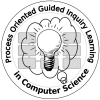
http://cspogil.org/Home
Process Oriented Guided Inquiry Learning (POGIL) is an in-class instructional strategy where students work in teams on guided activities where they build their own knowledge of the concepts, flipping the insturctor from lecturer to facilitator ("sage on the stage" to "guide on the side"). This also supports students engaging in processing skills, other than listening, such as communicating with their peers, critically thinking about given questions/problems, and collaborating to solve problems. The CS POGIL project began in 2011 with software engineering and data structures courses, expanding to introductory courses in the 2017 NSF-funded project. The CS-POGIL website has a wealth of resources in th eform of student activities, instructor guides (with answers), team activities, and learning objectives for each. There are both Java and Python versions for intro courses, however the examples are still within the common exercises in CS that focus purely on algorithmic, computational, and (sometimes) graphical approaches. They are great examples of how to embrace a different teaching strategy and became a powerful tool when building culturally sustaining approaches for the GOALS in CS grant project at MiraCosta. This is also one of the Computing Alliance of Hispanic Serving Institutions (CAHSI) Signature Practices for supporting Latinx/Chicanx students in CS.
Peer-Led Team Learning (PLTL) in CS
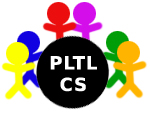
http://pltlcs.org/
In researching peer tutoring models in CS, there wasn't much information on embedded tutoring or supplemental instruction but another signature practice from the Computing Alliance of Hispanic Serving Institutions (CAHSI) is Peer-Led Team Learning (PLTL). PLTL is an institutional approach to supporting students, a program supported by the department and institution with funds and other kinds of support to provide peer leaders are trained in group work facilitation for classroom activities. Examples in STEM range from small activities during lectures to separate weekly workshops, similar to labs. The PLTL in CS website has a searchable database of activities in several languages (including C++ and Java). Note that most documents are more of a description of the activity, only a few provide answer keys or are as thorough as CS-POGIL. If you're looking for more ideas on exercises, this is also a good place to start noting that it also lacks any culturally relevant/sustaining approaches. Similarly to CS-POGIL, it can help with brainstorming and elevating the PLTL activities when using that pedagogy. PLTLs true strength, in my eyes, lies in the institutional approach to supporting students by providing a large community, network, and resources to create a program of support for students. Oftentimes the burden is left solely on the faculty, PLTL creates an opportunity for the college to leverage its resources and power to support students in the classroom by institutionalizing targetted and intentional services in proven practices. The main website, https://pltlis.org/, provides guides on how to start a PLTL program, training manuals, and more that would be useful to department chairs and program directors that are interested in building a support service for CS students and faculty. The experience peer leaders would get, especially at the beginning of their higher education journey at the community college, is unparalleled for those interested in pursuing teaching in CS. Unfortunately, several of the research studies and examples focus on volunteers for the peer leaders. The impact of hiring minoritized students in CS for paid positions as peer leaders could be transformative on several levels.
Peer Instruction for CS

http://peerinstruction4cs.com/
If you're looking to create more interaction in your lecture-based class, peer instruction is a great way to leverage students knowledge and collaboration to suppor their learning. Contrary to popular belief, peer instruction is not relying on students to complete the readings/videos and teach each other in class. Instead, it is the faculty creating an environment for students to collaborate in their learning by leveraging their knowledge bases (in our case) to solve problems. The resources on this website provide CS1 and CS2 (in Java and Python) materials to add "clicker question" slides to your lectures. Common in many Biology/Chemistry courses, students answer questions on a handheld "clicker" device so the instructor can measure their understanding as a class. Students can engage in group and class discussion to iterate over the question. Rather than asking a question in the lecture and having the same students answer each time, this creates an environment that engages students in a non-auditory style of learning through collaboration, discussion, writing, and critical thinking. It is a great tool that improves your teaching and can lead to deeper curriculum changes, like POGIL.
NCWIT: EngageCSEdu
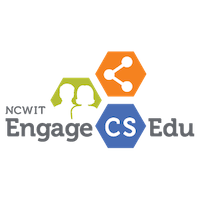
http://engage-csedu.org
The National Center for Women & Information Technology (NCWIT) is a powerful organization to familiarize yourself with and share with your students. They provide scholarships, programs, mentorship, and other resources for female students in tech. In addition, they also provide support for faculty, both at the program- and course-level. As an instructional faculty, the EngageCSEdu collection of materials and engagement practices is incredibly useful, especially for their equity-minded approach. Under engagement practices, you can find the frameworks that guide their practices: Make it Matter, Build Student Confidence & Professional Identity, and Grow an Inclusive Student Community. Resources on culturally relevant pedagogy, inclusive teaching practices, and universal design for learning provide a foundation for their approach that aligns with this literature review. In addition, they have a searchable database of classroom materials for all CS course levels and subjects. Each material highlights the engagement practices that are employed, contains links to materials (sometimes answer keys and lesson plans), as well as recommendations if using the exercise. You may not have as much coverage as the other OER materials for a specific course, but what you get here is quality over quantity. Think of how to combine and restructure these activities with POGIL for more bang for your buck!
Tech Tools
These materials provide tools for the classroom for material delivery, programming, communication, and collaboration. Out of all the spaces, this will be the one that goes out of date the fastest. As time goes on, finding tools that your student community already uses (at this time for me, Discord) and is comfortable with will be key. Get to know your students to see what they're currently using, but also keep up with industry trends to use tools that will prepare them for industry (source control, ticket tracking, scrum boards, etc.)
Carnegie Mellon Universities’ Open Learning Initiative (OLI)
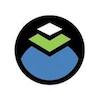
https://oli.cmu.edu
OLI offers a low-cost affordable textbook replacement option compared to traditional CS textbooks used. As part of our departments grant work throught the California Learning Lab, in collaboration with CSU San Marcos, we have built OLI courses for CS111 (Intro to CS: Java 1) and CS112 (Intro to CS: Java 2). These courses contain the technical content and interactive exercises throughout the pages and sections for each topic. They are organized and customized to our institution, so as a department we can collaborate on iterating over them to improve them and continue to improve on the culturally releveant/sustaining practices within the course content. Although affordable, the downside of the cost can be addressed as a department. Rather than offer it as the $25/student cost (or bulk discounted rate), the department can apply for grants to cover the cost for all CS111 and CS112 students.
Jupyter Notebooks

https://jupyter.org/
An amazing open-source interactive development environment that can deployed both as web-based and as a downloadable application. I would deem this the future of CS textbooks (and beyond even!), where you have content with REPLs (read-execute-print-loop interactive shell) with code examples. A student can run the code, as well as edit and play with it on the spot. The notebooks are editable, meaning students can add their own notes and make their own version of the textbook. Imagine, a collaborative classroom where the students can rewrite the textbook and make it their own! On their personal computers, they would install the Jupyter Notebook environment that allows them to run a Jupyter Notebook, taking advantage of the ease of using the web-based approach (no setup) but allowing a student to have an offline setup if they choose. The big downside at this time is that Java is still in development without enough support to use as the primary content delivery system. Python is its most popular and full-featured language, along with R and Scala. Installation can get technical, but with some automation (Docker?) it may be a good option in the future for content delivery.
Repl.it Teams

https://replit.com/teams-for-education
Similar to GitHub Education, this platform facilitates course deliver by automating and tracking programming projects for a course. The most significant difference, however, is the full web-based IDE that the platform is built on. Students don't need to waste time trying to get an IDE/Dev Kit installed, they can jump straight into programming in several languages the platform supports (Java, C++, Python, etc). There are tons of projects and samples shared by the community, along with automated grading tools, but my favorite tool is the Multiplayer mode that essentially becomes a Google Doc for programmers to collaborate on writing code together. This opens up opportunities, both in and out of the classroom, to work together in problem solving and debugging projects.
GitHub Education
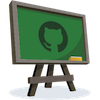
https://education.github.com/
GitHub Education is a platform for faculty and students to take advantage of GitHub, a cloud-based code repository manager, along with a suite of free tools and services. You start by signing up for the Education account, as faculty or student, by uploading proof that gives you a 1-year account. Usually within 24 hours you will receive approval, which allows students and faculty to access paid-version of software and services. Additionally, for faculty, you can order a "swag" bag for your students that contains git cheatsheets, GitHub flow guides, markdown guides, and stickers. It's a free gift that can help create a sense of community much like attending hackathons. The most powerful tool currently is the GitHub Classroom tool to automate your course by taking the tediousness of creating and organizing repos for your students. It makes grading much simpler, especially when you integrate auto-grading through continuous-integration and unit testing. The best part is, you can reuse those repositories and collaborate with other faculty. For example, our CS113 course at MiraCosta has integrated those changes so that any faculty teaching that class can focus on supporting students through difficult problem solving and feedback rather than technical difficulties and gruntwork at the course level.
Trello

https://trello.com/
If we can find ways to teach by doing, rather than by listening, we can step into the direction of empowering our students. Even in introductory courses, where we often feel like we aren't covering advanced enough material to connect with practical industry practices, we can introduce software engineering tools like Trello to students. Used as a digital Kanban board, a popular framework to implement agile/scrum software development, it allows an accessible way to collaborate with real-time communication and transparency of work. It can be simply used in an intro course as a to-do list tracker for the course or everything in a students semester. You can integrate it as the faculty by creating weekly/unit to-do lists that students can copy to track their own progress. In project courses with group work, I've used them to organize essential milestones for a teams project and use the more powerful features like designating who's responsible for certain tasks, adding deadlines, and breaking down user stories into discrete tasks to distribute work. When integrating into the classroom, either for individual or group work, it can create the space for using software engineering terminology beyond comprehension to application. Trello is mobile-friendly (Android, iOS), as well as a desktop (Windows, mac os) and web application to allow students the flexibility to use whichever method they feel most comfortable in accessing the tool.
Discord

https://discord.com/
"As a classroom community , our capacity to generate excitement is deeply affected by our interest in one another , in hearing one another’s voices , in recognizing one another’s presence ." - bell hooks, Teaching to Transgress
Chat application, similar to Slack with similar and parallel features, that started with the gaming community and exploded into tech and other spaces. Very student friendly, over the last couple of years (circa 2021) most CS students are at least familiar with it. For example, the Women in CS (WiCS) and CompSci (CS) Clubs use them as their primary communication/organizing platform. The same benefits as Slack apply, although the barrier of entry may be smaller at the class-level since so many students are familiar with it. I prefer this in the introductory courses while using Slack for our more advanced project classes. There is a relevant article in the NY Times (https://nyti.ms/39rl10K) about white supremacist using the app that could connect well with CSP approaches in CS teaching. This can bring in a conversation of how what we create are tools, and those tools can be used by anyone and for whatever reason.
Here's a template that can be used in class https://bit.ly/3CCOmBJ along with some community guidelines:
The following are basic community guidelines, not just for Discord but in any shape our classroom takes (private messages, emails, discussion board posts, Zoom calls, etc.). These apply to everyone, faculty, tutors, students, everybody:
- Be respectful: respect me, I'll respect you. Respect one another and we will all move forward in learning
- Be present: Be present mentally, whether it be on a Zoom call or interacting here on Discord. The more active we are in the course the more learning we can do
- Be conscious of time: raise your hand to speak on Zoom calls, be aware of how long you speak to give time for others, and allow space for others to think and answer. If you haven't participated yet, give yourself the opportunity to engage as we learn together
- Be yourself: we need you here, all of you. The conversations and learning we do deserves your full presence
- Don't be afraid to be wrong: "Why do we fall Master Wayne? So that we can learn to pick ourselves up" -Alfred Pennyworth.You have to make mistakes to learn, theres no way around that. Making less mistakes doesn't mean you're smarter or more capable. The more you try, the more you want to learn, so the more likely we'll experience some failures. We'll keep getting back up together, promise
- NO intellectual bullying: Using technical vocabulary, from the course but especially beyond this course, can be used as a form of supremacy. We're here to learn, not bully each other or show off that we know "more". Listen, ask, and engage thoughtfully
- NO cultural criticisms: Blanket statements and stereotypes that treat a group as a monolith take away from the humanity of people and the nuance of problem solving. We need to dive into the details, so be specific and accurate. Don't speak for others, only from your experiences.
Do you have others you'd like to add or emphasize? Feel free to post here, as well as some strategies that might help
Slack

https://slack.com/
"It is rare that any professor , no matter how eloquent a lecturer , can generate through his or her actions enough excitement to create an exciting classroom . Excitement is generated through collective effort ." - bell hooks, Teaching to Transgress
Chat application that is often used in the tech industry as a replacement for email, they were recently acquired by Salesforce. There are also affinity groups, like Techqueria https://techqueria.org/ for Latinx in Tech), that use it as a community space to organize and share resources. Our department currently uses it as the primary communication platform for our California Learning Lab grant work MiraCosta team. The free version allows several useful features and customizations to personalize the Slack workspace, such as adding apps like Zoom or Google Docs that integrate into those services. The creation of channels, separate groups within an organizations workspace, allows you to organize conversations around a channel theme or topic. Private channels can be created to simplify collaboration and minimize clutter so the workspace can receive only the necessary notifications. There are appliations for the desktop (Windows, mac os) and mobile apps (Android, iOS), as well as login through a webbrowser, which allows support for students on whatever platform(s) they're most comfortable on. To build a classroom community, it allows you a lot more control than any of the Canvas integrations while exposing students to industry-related tools. Along with collaborating as a class in the public channels, private channels allow students to create their own study groups or faculty to create group private group project channels to support each group.